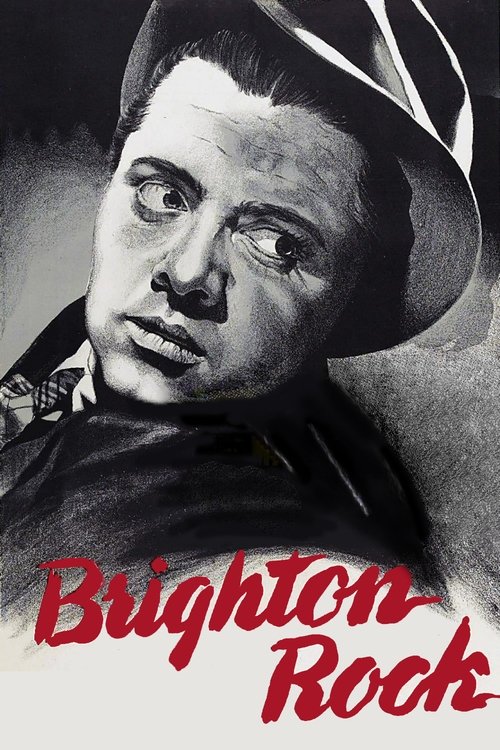Movies this old require some extra context. If you’re weak on your confectionary terms (I was), you might not know that “Rock” refers to stick-shaped hard candy. I’ve seen plenty of these in little tourist trap gift shops, and occasionally bought them myself. “Brighton rock,” then, is the rock stick candy sold on the beach in Brighton. They are inexpensive and long-lasting, and I don’t know that I ever finished one before I got tired of it. In this 1948 film based on Graham Green’s 1938 novel of the same name, “Brighton Rock” stands as a metaphor for being stubborn.
“I’ve never changed. I’m like those sticks of rock,” says local entertainer Ida Arnold. “Bite all the way down, you still read ‘Brighton.’”

Newspaper reporter Fred “lamps” (I think that’s the lingo) Dallow, Pinkie, and Cubitt oozing up behind him at the bar.
What Ida is being stubborn about is the disappearance and murder of newspaper reporter Fred Hale. Hale’s reporting led (indirectly) to the murder of Kite, a small-time gang boss running a slot-machine racket. His successor Pinkie wants revenge, but when the opportunity presents itself Pinkie gets a little carried away and Hale ends up dead. Most of the rest of the movie is about Pinkie’s efforts to cover up the murder while trying to keep his turf out of the hands of a much bigger mobster, Colleoni, who is taking advantage of Kite’s murder to make a movie on the territory.
Ida’s research turns up a potential witness, a young naïf named Rose. Pinkie has also realized that Rose is a crucial witness, and is taking steps to keep her quiet. Murder is out of the question, though, with Ida sniffing around — so he has to be a bit more cunning.
Brighton Rock is a complex story well-told in just over ninety minutes, a dark story about these three — Ida, Pinkie, and Rose — who are each, in their own way, as unchanging as Brighton rock. Both Pinkie and Rose are given many opportunities to steer clear of disaster from just about everyone involved, but do they? Do young lovers ever?

The story has more than a passing resemblance to Romeo & Juliet, but with one crucial difference…
Graham Greene was not only a literary giant but also a popular author of his time, and he took an active role adapting his novel to film. Not that he was in total control, however — the movie’s ending, already fairly dark, is considerably happier than that of the novel.
Pinkie is played by Richard Attenborough, who was twenty-five at the time of release but looks far younger. Although young, Attenborough was already an accomplished actor, and was in many great movies after Brighton Rock. He was also the very grandfatherly John Hammond in 1993’s Jurrasic Park. Attenborough inhabits the role of Pinkie entirely, which stands to reason — he played Pinkie several years earlier in the stage adaptation of the novel.
Pinkie’s second, Dallow, is played by the future first Doctor William Hartnell. By 1948 Hartnell had been typecast as a “heavy,” no doubt aided by his criminal teenage years. Hartnell’s role seems like a small supporting one at first, but there’s enough of Dallow to satisfy those curious to see Hartnell in something other than a low-budget television series.

Here’s what Fred saw in the mirror. Pinkie’s the one who looks like a truant officer is after him.
I am not sure if it’s by virtue of the film’s age or Greene’s writing, but Brighton Rock sets up plenty of familiar sub-plots and then defies expectations. In later films, Ida (Hermione Baddeley) would be a Jessica Fletcher, or maybe a Mrs. Marple. Here, she’s just a complicating factor in the story — backing both Rose and Pinkie into corners they might not otherwise get into. The focus is pretty squarely on Pinkie and Rose, and you know — because it’s a noir, of course — that things are not going to end well for them. The film is only occasionally marred by mid-century Hollywood melodrama, but those scenes are usually done before you can finish rolling your eyes.
The version of Brighton Rock I watched was released in the United States by Kino Lorber, nicely restored but without much in the way of extras. It’s a stand-out noir and fantastic example of English cinema. If you can’t catch it somewhere streaming, it’s an excellent movie to pick up during one of Kino Lorber’s frequent sales.

